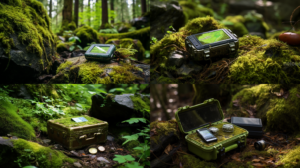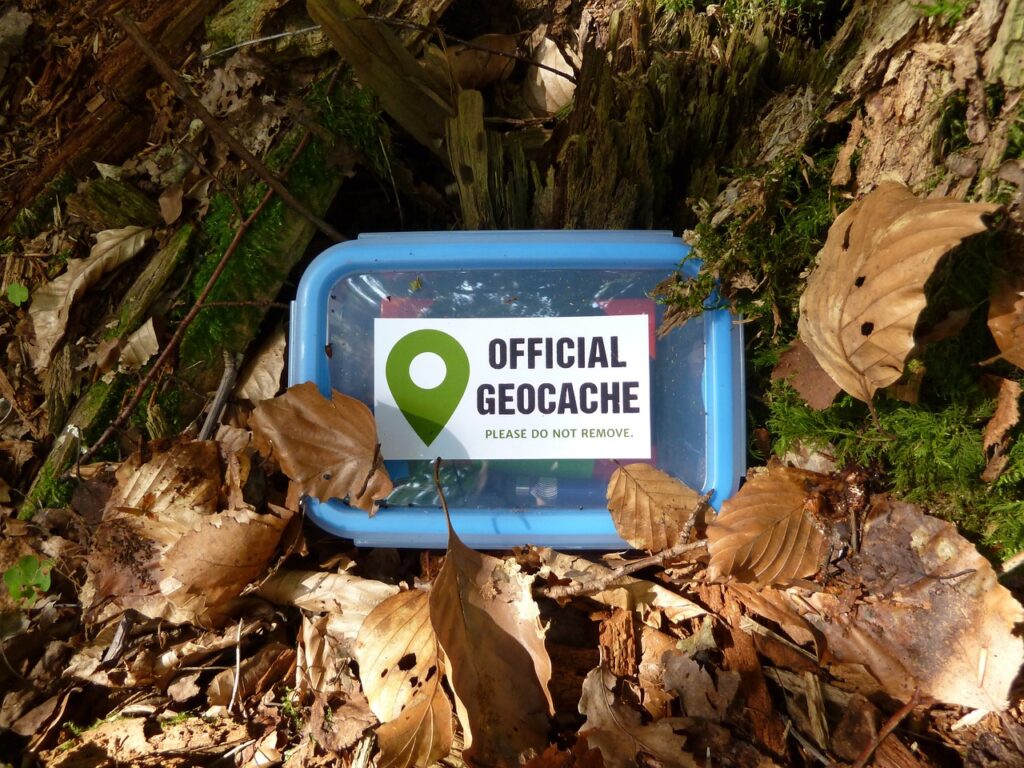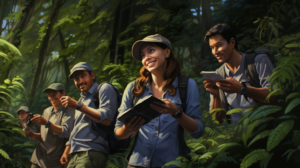Geocaching, an exciting outdoor activity enjoyed by millions worldwide, combines the thrill of treasure hunting with the precision of GPS technology. With over 3 million active caches hidden at specific locations around the globe, geocaching offers a unique and adventurous way to explore the world. Participants, armed with GPS receivers, search for hidden containers known as “geocaches,” which often contain a logbook and items for trading. From traditional caches to multi-cache and mystery caches, there is a wide variety for everyone to enjoy. Whether you’re a beginner or an experienced geocacher, this fascinating hobby guarantees endless excitement and the opportunity to connect with a rich online community. So grab your GPS device and embark on a thrilling geocaching adventure today!
Video Summary of this post.
What is Geocaching?
Definition of Geocaching
Geocaching is an exciting outdoor recreational activity that combines technology, exploration, and treasure hunting. Participants, known as geocachers, use GPS receivers to hide and seek containers called “geocaches” at specific locations all around the world. It’s like a real-world scavenger hunt, where you rely on your GPS coordinates to guide you to the hidden treasures.
How GPS receivers are used
GPS receivers, also known as GPS units or handheld GPS devices, are essential tools for geocaching. These devices use a network of satellites to determine your exact location on Earth. Geocachers input the GPS coordinates of a geocache into their GPS receiver, and the device guides them to the cache by providing directions and distance. GPS receivers have made geocaching possible by eliminating the need for maps and compasses, and significantly improving the accuracy of finding hidden caches.
Types of containers used in geocaching
Geocaches come in various shapes and sizes, and the containers used to hide them can be equally diverse. A common type of container is a small, waterproof plastic box that can hold a logbook and small trinkets. These containers are designed to protect the logbook and any items inside from the elements. However, geocachers also use other creative containers such as ammo boxes, film canisters, and even fake rocks or tree stumps to make finding the cache more challenging and exciting.
History and Evolution of Geocaching
Origin of geocaching
Geocaching as we know it today was born in the year 2000. It was conceived shortly after the United States government removed Selective Availability from the GPS system, a feature that intentionally degraded the accuracy of public GPS signals. With the introduction of more accurate GPS coordinates, geocachers were able to hide and find hidden treasure boxes with unprecedented precision.
Removal of Selective Availability from GPS system
Selective Availability was implemented as a security measure to prevent potential adversaries from using GPS signals for precise military purposes. However, with advancements in technology and improvements in navigation systems, it became unnecessary and was finally turned off on May 1, 2000. This event opened up a whole new world of possibilities for geocaching.
First documented GPS-located cache
On May 3, 2000, just two days after the removal of Selective Availability, Dave Ulmer placed the first documented GPS-located geocache near Beavercreek, Oregon. This cache consisted of a black plastic bucket filled with various items, as well as a logbook for finders to record their discovery. The coordinates were posted on an internet forum, inviting others to try and find the hidden treasure. This marked the official beginning of geocaching as a global phenomenon.
Expansion to include extra-terrestrial caches
As geocaching gained popularity, it expanded beyond the bounds of planet Earth. Geocaches were placed on the International Space Station and even on Mars. These extra-terrestrial caches provide a unique challenge for geocachers and help foster a sense of adventure and exploration that goes beyond our planet’s surface.

How Geocaching Works
Finding and hiding geocaches
The thrill of geocaching lies in both finding and hiding geocaches. Geocachers can search for nearby caches using a GPS receiver or a smartphone app. They follow the coordinates until they reach the cache’s location, using their observational skills to uncover the hidden container. Once found, they can sign the logbook and sometimes take or leave small trinkets or trackable items.
On the other hand, geocachers can also hide their own caches for others to discover. They choose a location, create an interesting cache container, and place it, along with a logbook, at the designated spot. The cache’s coordinates are then shared on geocaching websites or platforms for fellow treasure hunters to find.
Recording finds in logbooks and online
When a geocacher finds a hidden cache, it’s important to leave a record of their visit. Inside each cache, there is a logbook where geocachers can sign their names and write a message. This tradition helps geocachers connect and document their adventures. Additionally, geocachers can log their finds online via geocaching websites or mobile apps, which allows them to share their experiences, rate the difficulty of the find, and provide helpful hints for future seekers.
Taking and leaving items in the cache
Many geocaches also contain small trinkets such as toys, keychains, or collectible items. One of the fun aspects of geocaching is the ability to trade items in the cache. If a geocacher takes an item from the cache, they are expected to leave an item of equal or greater value in return. This act of trading adds an extra layer of excitement and surprise to the geocaching experience.
Different sizes and difficulty levels of geocaches
Geocaches come in various sizes, ranging from small micro caches, which can be as tiny as a film canister, to large ammo boxes or even bigger containers. The size of the cache can affect the difficulty level of the search, as smaller caches are more challenging to find. Difficulty ratings are also provided to help geocachers decide if a cache is suitable for their skill level. These ratings consider factors such as terrain and the camouflage of the cache container.
Types of caches: Traditional, multi-cache, and mystery caches
Traditional caches are the most common type of geocache. They consist of a container hidden at the given coordinates, and the cache information provides all the necessary clues to find it. Multi-caches involve multiple stages, with each stage providing a clue to the next, leading geocachers on a journey of discovery. Mystery caches, also known as puzzle caches, require geocachers to solve puzzles, riddles, or codes to unlock the cache’s coordinates.
Geocaching Equipment
GPS receivers
A GPS receiver is an essential tool for geocaching. They come in various forms, from handheld devices specifically designed for outdoor activities to smartphone apps that utilize the built-in GPS capabilities of your phone. When choosing a GPS receiver, consider factors such as battery life, durability, and accuracy. Some receivers offer additional features specifically tailored for geocaching, like preloaded caches and mapping capabilities.
Smartphone apps for geocaching
With the widespread use of smartphones, many geocachers rely on dedicated geocaching apps. These apps provide an all-in-one solution for finding, hiding, and logging caches. Geocaching apps use the GPS capabilities of your smartphone to guide you to the cache’s location and provide access to online features, such as logging finds and accessing up-to-date cache information. They have become increasingly popular due to their convenience and ease of use.
Additional tools and gear
While a GPS receiver or smartphone app is the most crucial piece of equipment for geocaching, additional tools and gear can enhance the experience. Some geocachers carry a pen or pencil to sign logbooks, as well as small trinkets to trade. Others may bring a magnifying glass to help them uncover hidden micro caches, or a flashlight for searching in low-light conditions. It’s also essential to dress appropriately for the weather and pack essentials like water, snacks, and a first aid kit.

Popular Geocaching Locations
Urban areas
Geocaches can be found in the heart of bustling cities, offering a unique urban adventure. Urban caches may be hidden in parks, historical landmarks, or even camouflaged amidst the everyday structures of city life. Geocachers can navigate through city streets, solving clues and searching for hidden treasures while immersing themselves in the vibrant atmosphere of urban life.
Parks and nature reserves
Nature lovers and outdoor enthusiasts often find solace in geocaching in parks and nature reserves. These locations provide a tranquil setting for treasure hunting, with caches hidden in trees, under rocks, or near scenic viewpoints. Geocachers can enjoy the beauty of nature while embarking on an exciting quest to discover hidden caches.
Historical sites
Geocaching offers an excellent opportunity to explore historical sites and landmarks. Historical caches may be hidden near significant monuments, ancient ruins, or places of cultural importance. By participating in geocaching at these locations, you not only enjoy the adventure of finding the cache but also gain insights into the history and heritage of the area.
Mountains and hiking trails
For those seeking a more adventurous geocaching experience, mountains and hiking trails present a thrilling challenge. Geocachers can embrace the beauty of nature while traversing rugged terrains, climbing mountains, and navigating through dense forests. These caches often require physical exertion and involve a sense of accomplishment upon their discovery.
Other unique and challenging locations
Geocaching knows no bounds when it comes to unique and challenging locations. Some caches can be hidden underwater, requiring divers to explore the depths and find hidden containers. Other caches are placed on islands or even in caves, adding an element of exploration and adventure. The diverse range of cache locations ensures there is always something new and exciting to discover.
Tips and Strategies for Successful Geocaching
Understanding geocache descriptions
Before embarking on a geocaching adventure, it’s crucial to read and understand the geocache description. Descriptions provide vital information such as the cache size, difficulty rating, terrain rating, and any special requirements or equipment needed. Take note of any hints or clues provided, as they can significantly assist you in finding the hidden cache.
Using hints and clues effectively
When faced with a challenging cache, hints and clues can be valuable resources. These hints, often provided by the cache owner, offer extra guidance to help you locate the hidden cache. It’s essential to use hints wisely, as they can range from straightforward to cryptic. Learning how to interpret hints effectively will improve your chances of success in finding the cache.
Being prepared with necessary supplies
Geocaching can take you to remote areas or challenging terrains, so it’s essential to come prepared. Carry essential supplies such as water, snacks, a map or compass, a pen or pencil for signing logbooks, and any specific tools mentioned in the cache description. Dress appropriately for the weather and consider packing additional gear like a magnifying glass or flashlight if necessary.
Navigating tricky terrains
Some geocaches require venturing into challenging terrains, such as steep slopes or dense forests. Always prioritize safety and be aware of your surroundings. Stay on designated paths and trails whenever possible. Bring a map or use your GPS receiver to stay on track. If the terrain seems too dangerous or inaccessible, consider skipping the cache and moving on to the next one.
Searching during different weather conditions
Weather conditions can greatly impact the geocaching experience. While clear skies and sunny days may seem ideal, different weather conditions can offer unique challenges and opportunities. Rain can reveal hidden geocaches by washing away debris, while snow can create a picturesque landscape for treasure hunting. However, always prioritize safety and avoid hazardous conditions that could compromise your well-being.

Benefits and Enjoyment of Geocaching
Adventure and exploration
Geocaching offers a thrilling sense of adventure and exploration. Whether you’re searching for hidden treasures in a bustling city or embarking on a mountainous quest, geocaching takes you to places you may have never discovered otherwise. Each cache presents an opportunity for a new adventure and allows you to explore both familiar and unfamiliar areas with fresh eyes.
Physical exercise
Geocaching is an excellent way to incorporate physical exercise into your outdoor activities. As you traverse various terrains and embark on treasure hunts, you engage in walking, hiking, climbing, and navigating, all of which contribute to increased fitness levels. Geocaching can be a fun alternative to traditional forms of exercise, as it combines physical activity with the excitement of a real-world treasure hunt.
Mental stimulation
The mental stimulation provided by geocaching is one of its greatest benefits. Geocachers need to interpret coordinates, read descriptions, solve puzzles, and use observational skills to find hidden caches. This mental challenge keeps the mind sharp and enhances problem-solving abilities. Geocaching provides an engaging activity that stimulates the brain while fostering a sense of curiosity and discovery.
Connecting with nature
Geocaching provides a unique opportunity to connect with nature and appreciate the beauty of the great outdoors. Whether you’re exploring a park, hiking through a forest, or traversing mountains, geocaching immerses you in natural environments. The experience of finding hidden treasures amidst serene landscapes fosters a deeper appreciation for nature’s wonders and encourages environmental stewardship.
Building a sense of community
Geocaching is not just an individual endeavor; it’s a community-driven activity. Geocachers come together to share their experiences, tips, and stories on online platforms and at geocaching events. There is a sense of camaraderie among geocachers who share a common passion for exploration and adventure. Participating in geocaching can lead to lasting friendships and connections with like-minded individuals.
Ethics and Rules of Geocaching
Respecting nature and property
Geocachers have a responsibility to respect the environment and the properties where caches are hidden. When searching for a cache, refrain from disturbing natural habitats or damaging vegetation. Ensure you leave the cache location as you found it, without leaving any trace of your visit. Be mindful of private property and practice good etiquette by seeking permission before accessing caches on private land.
Replacing caches properly
If you discover a geocache and decide to take an item, it’s essential to replace it with something of equal or greater value. This ensures an equal trading experience for future finders. When handling the cache, be careful not to damage it or expose it to the elements. Take extra precautions with delicate or fragile cache containers to maintain their integrity.
Reporting damaged or missing caches
Occasionally, a geocache may be damaged or go missing due to various factors such as natural disasters or vandalism. If you come across a damaged or missing cache, it’s crucial to report it to the cache owner or the relevant geocaching website or platform. This allows the owner to address the issue and ensure the cache is maintained or replaced for future geocachers.
Respecting geocache guidelines
Each geocache owner may establish specific guidelines for their caches. These guidelines may include instructions on how to approach the cache, any hazards to be aware of, or special requirements for logging your find. It’s important to adhere to these guidelines to maintain the integrity of the geocaching experience and show respect for the cache owner’s intentions and efforts.
Being mindful of other geocachers
Geocaching is a shared activity, and it’s crucial to be considerate of other geocachers. When hunting for a cache in a high-traffic area, be mindful of other individuals who may be searching for the same cache. Avoid revealing the cache’s hiding spot to ensure a fair and exciting experience for others. Additionally, be respectful in online forums and communities, understanding that everyone has their unique geocaching experiences.
Geocaching Websites and Platforms
Geocaching.com
Geocaching.com is the largest and most well-known website dedicated to geocaching. It hosts a vast database of geocache listings from all over the world. Geocachers can create an account, search for caches in their area or desired location, find helpful hints and tips, and connect with other geocachers. Geocaching.com also offers premium membership options that provide additional features and perks.
Other popular geocaching websites
While Geocaching.com is the dominant platform, there are other websites catering to geocachers. Some of these alternatives offer unique features or focus on specific regions or countries. Websites like Opencaching, Terracaching, and Navicache provide a different perspective on geocaching and offer additional options for finding and logging caches.
Mobile apps for geocaching
In addition to websites, there are numerous mobile apps designed specifically for geocaching. These apps allow geocachers to search for caches, read descriptions and hints, log finds, and connect with the geocaching community, all from the convenience of their smartphones. Popular geocaching apps include “Geocaching” (official app), “Cachly,” and “Looking4Cache.”
Conclusion
Recap of geocaching’s appeal
Geocaching offers a unique and thrilling outdoor adventure for individuals of all ages and backgrounds. It combines technology, exploration, and treasure hunting to create an activity that stimulates both the mind and body. By using GPS receivers or smartphone apps, geocachers can embark on real-world scavenger hunts, connecting with nature, history, and fellow treasure hunters along the way.
Encouraging readers to try geocaching
If you’re seeking a new and exciting way to explore the world around you, geocaching is the perfect activity to fulfill your adventurous spirit. With millions of active caches worldwide, there is no shortage of treasures waiting to be discovered. Whether you’re an experienced outdoors enthusiast or simply looking for a fun family activity, geocaching offers an adventure that will captivate and inspire you.
Final thoughts on the activity
Geocaching transcends the boundaries of traditional outdoor activities and creates a sense of wonder and exploration. It allows individuals to engage with technology, connect with nature, and build connections with fellow geocachers. As you embark on your geocaching journeys, remember to respect the environment, follow ethical guidelines, and enjoy the thrill of the hunt. So grab your GPS receiver or smartphone, embark on a geocaching adventure, and prepare to discover hidden treasures in the most unexpected places. Happy caching!
